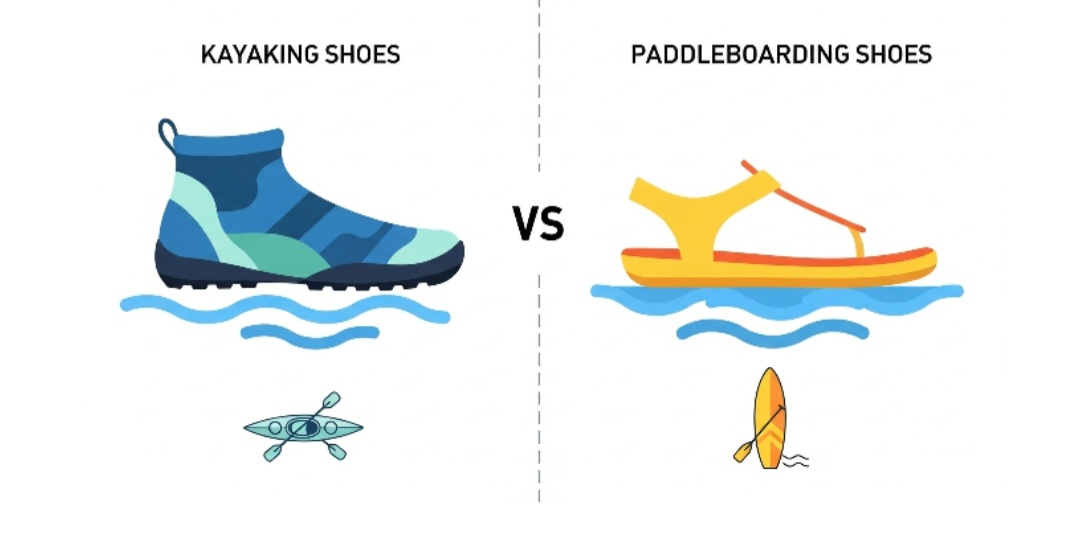Choosing the right water shoes isn’t just about comfort. Traction determines safety and performance. Kayaking and paddle board shoes demand different traction features. Here’s how to pick wisely.
Why Traction Differs Between Kayaking and Paddle Boarding
- Kayaking shoes need multidirectional grip for:
- Riverbank scrambles over slippery rocks.
- Bracing against footpegs during rapid maneuvers.
- Portaging kayaks across muddy or uneven terrain.
- Paddle boarding (SUP) shoes prioritize:
- Board deck grip to prevent slips during stance changes.
- Barefoot-like sensitivity for balance adjustments.
- Shallow-water traction when launching/landing.
Key Traction Features Compared
1. Sole Design
- Kayaking: Aggressive lugs (e.g., Vibram®) for muddy banks and algae-covered rocks. Models like the Adidas Trail Cross XT use deep treads for whitewater hikes.
- SUP: Flat, flexible soles (e.g., Vibram Megagrip) for board contact. Vibram FiveFingers V-Aqua uses siped rubber to mimic barefoot grip.
2. Drainage & Water Flow
- Kayaking: Quick drainage prevents weight buildup. The Astral Loyak uses mesh uppers and ported soles to shed water in seconds.
- SUP: Fast-drying materials avoid “sloshing.” Body Glove 3T Barefoot Hero uses drainage slots to keep feet light.
3. Fit and Mobility
- Kayaking: Snug ankles prevent shoe loss in currents. NRS Kicker Boots use neoprene cuffs for security.
- SUP: Toe articulation aids balance. Merrell Hydro Glove features a roomy toe box for natural splay.
4. Warmth vs. Breathability
- Kayaking: Neoprene (e.g., NRS Paddle Wetshoe) insulates in cold rivers but drains slowly.
- SUP: Lightweight mesh (e.g., Astral TR1 Mesh) cools feet in warm conditions.
5. Durability and Wear
- Worn soles reduce traction by 16–38%.
- Kayaking: Reinforced rubber toes (e.g., Palm Gradient 3.0) resist abrasion.
- SUP: Thin soles wear faster but prioritize flexibility. Replace after ~500 km.
Top Models Compared
| Model | Best For | Traction Tech | Drainage | Warmth |
| Hosers.co | Kayaking | G Rubber™ (rock stickiness) | Excellent | High |
| NRS Kinetic | SUP (cold) | Textured rubber | Good | High |
| Adidas Trail XT | Kayak portages | Grippy rubber lug sole | Moderate | Medium |
| Vibram V-Aqua | SUP (warm) | 5-toe Megagrip™ | Excellent | Low |
3 Quick Selection Tips
- Test flexibility: Bend the shoe. Kayaking gear should flex at the ball of the foot. SUP shoes should twist fully.
- Check the terrain: Sharp rocks? Choose kayaking shoes with thick soles. Sandy launches? SUP shoes suffice.
- Prioritize drainage if you’re in/out of water frequently. Slow-drying shoes cause blisters.
FAQs
Q: Can I use kayaking shoes for paddle boarding?
A: Yes, but they’re overbuilt. SUP needs minimal sole thickness for board feel.
Q: Do I need shoes for warm-water paddling?
A: For kayaking, yes—footpegs hurt bare feet. For SUP, optional unless rocks/debris are present.
Q: When to replace water shoes?
A: When tread wear exposes a smooth area >400mm². This increases slip risk by 286%.
The Bottom Line
Kayaking shoes need rugged, multidirectional traction for land and boat control. Paddle boarding shoes need board-adherent soles that won’t compromise balance. Match your shoe’s grip to your activity’s risks—not doing so costs performance and safety.



